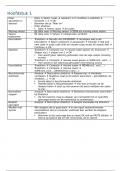Summary
Statistiek: data-analyse - samenvatting in woordenlijst-vorm
- Course
- Institution
Dit is een samenvatting van statistiek: data-analyse, een vak van het tweede semester van het schakeljaar naar de master in de verpleeg- en vroedkunde. De woordenlijst-vorm maakt het gemakkelijk om af te dekken en jezelf te bevragen.
[Show more]



